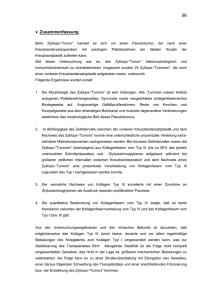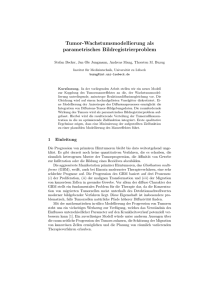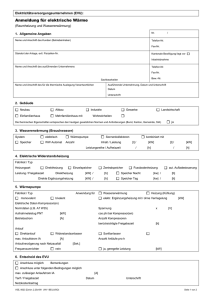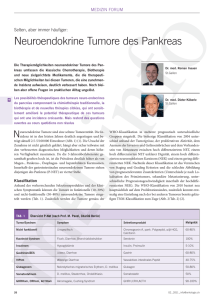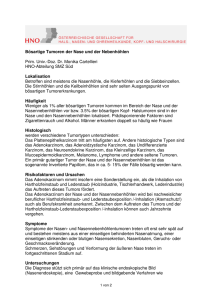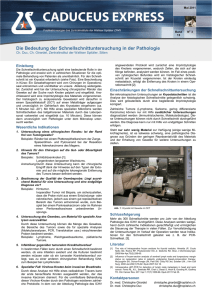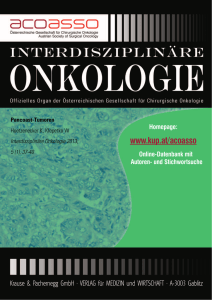N Krall Cumulative PhD Thesis v18 - ETH E
Werbung
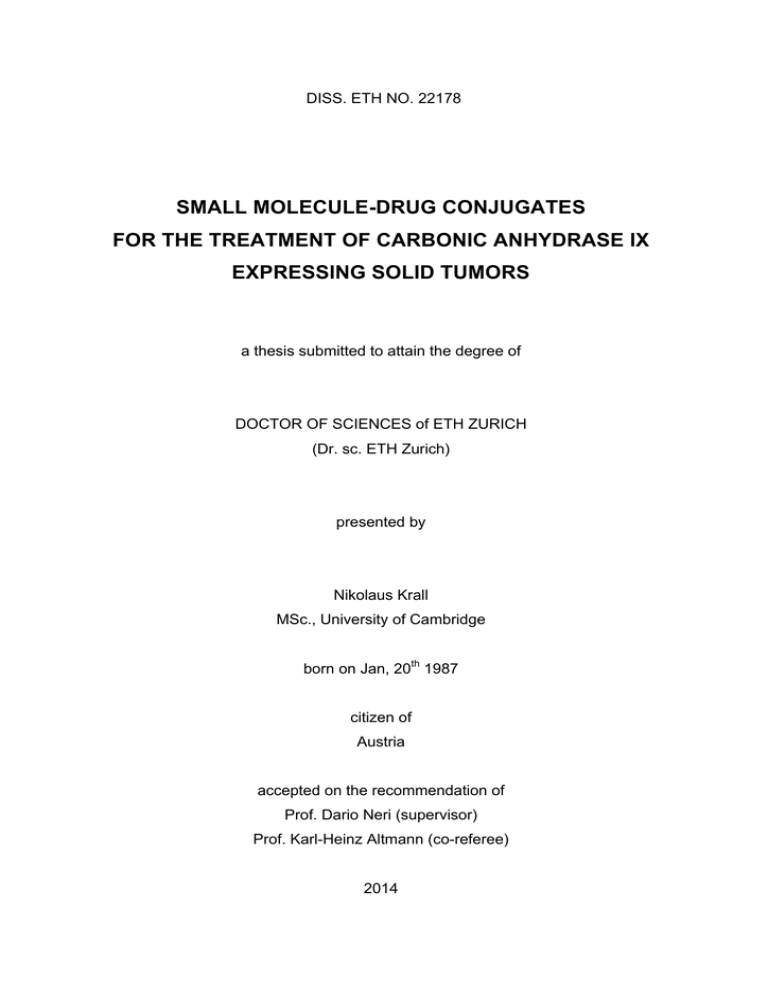
DISS. ETH NO. 22178 SMALL MOLECULE-DRUG CONJUGATES FOR THE TREATMENT OF CARBONIC ANHYDRASE IX EXPRESSING SOLID TUMORS a thesis submitted to attain the degree of DOCTOR OF SCIENCES of ETH ZURICH (Dr. sc. ETH Zurich) presented by Nikolaus Krall MSc., University of Cambridge born on Jan, 20th 1987 citizen of Austria accepted on the recommendation of Prof. Dario Neri (supervisor) Prof. Karl-Heinz Altmann (co-referee) 2014 I. 1. SUMMARY English Systemic chemotherapy with small-molecule cytotoxic drugs remains one of the cornerstones of modern cancer therapy. However, many low molecular weight cytotoxic drugs do not strongly localize to solid tumors but preferentially accumulate in healthy organs. An unfavorable biodistribution, combined with the non-specific mode of action of cytotoxic anticancer agents, can lead to severe side effects, dose limiting toxicities and may prevent the administration of therapeutically effective treatment regimens. Similar considerations may apply to so called “targeted drugs” such as tyrosine kinase inhibitors since many are not as selective as originally believed. The targeted delivery of highly potent cytotoxic drugs into solid tumors is emerging as promising strategy to overcome the intrinsic limitations of small-molecule anticancer agents. Indeed, some antibodies against accessible tumor markers have the striking ability to selectively accumulate inside neoplastic lesions and have been used for targeted drug delivery applications in the form of antibody drug conjugates. Yet, antibody carriers may suffer from limitations owing to their high molecular weight and long circulation in plasma. Antibodies may have difficulties penetrating deeply into solid tumors preventing the homogeneous targeting of all tumor cells. Long plasma circulation can lead to premature release of drugs from the antibody due to spontaneous cleavage of the linkage between drug and carrier and lead to unwanted systemic toxicities. We and others have proposed that small-molecule ligands of tumor cell surface antigens may overcome some of the limitations associated with antibodies as vehicles for targeted drug delivery applications. Small molecules typically penetrate solid tumors more rapidly than large macromolecules and normally have much shorter circulation half-lives. For the purpose of this study we focused on carbonic anhydrase IX (CAIX) – a tumor cell surface antigen up-regulated in response to hypoxia and strongly expressed in the majority of renal cell carcinoma. Using published structure-activity relationship data and a focused screen against recombinant CAIX, we identified small-molecule ligands that could tolerate the attachment of linkers and payloads yet maintain 6 binding to their target. Using small animal imaging techniques, we showed that one of our leads, which was derived from the approved anti-glaucoma drug acetazolamide (AAZ), coupled to a near-infrared fluorescent dye, strongly accumulated inside CAIX-expressing SKRC52 renal cell carcinoma xenografts. Using fluorescent microscopy and visible light dyes the remarkable tumor penetration capacity of small molecule conjugates was demonstrated. We furthermore extensively characterized their sub-cellular localization using confocal fluorescence microscopy and flow cytometry. Counter to previous suggestions that CAIX internalized upon ligand binding, we did not see strong internalization in the cell lines studied. A conjugate consisting of our AAZ-based targeting ligand and the potent cytotoxic maytansinoid DM1, connected through a disulfide linker, was prepared. Intravenous administration of this molecule strongly retarded the growth of SKRC52 xenograft tumors in mice. The therapy was well tolerated with no observable weight loss. Importantly, the standard-of-care drugs sunitinib and sorafenib did not show any benefit in the same model. Finally, a bivalent AAZ-based ligand was shown to have a higher functional affinity for CAIX in vitro compared to its monovalent counterpart. A bivalent ligand-dye conjugate accumulated inside SKRC52 tumors more strongly at late time points than monovalent controls. In terms of therapeutic efficacy, a proportion of mice bearing SKRC52 xenografts could be sustainably cured using a bivalent ligand-drug conjugate. This had previously not been possible with monovalent ligand-drug conjugates. To the best of our knowledge, we have developed the first small-molecule based drug delivery strategy targeting CAIX expression in solid tumors. Our conjugates showed remarkable efficacy in a xenograft model of renal cell carcinoma, which did not respond to standard of care drugs sorafenib and sunitinib. Bivalent targeting ligands may be superior delivery vehicles compared to their monovalent counterparts. This is in full analogy to the observation that bivalent antibody formats accumulate more strongly in solid tumors than monovalent ones. We are now further evaluating the therapeutic potential of our drug delivery strategy using different linkerpayload combinations and additional models of CAIX-expressing renal cell carcinoma. 7 2. Deutsch Systemische Chemotherapie mit niedermolekularen zytotoxischen Substanzen ist noch immer ein wichtiger Bestandteil moderner Krebstherapie. Kleine Moleküle erreichen solide Tumore jedoch nicht immer in ausreichendem Masse sondern reichern sich oft in gesunden Organen an. Zusammen mit dem nichtspezifischen Wirkmechanismus konventioneller Chemotherapeutika kann dies zu schweren und dosislimitierenden Nebenwirkungen führen und so die Gabe von therapeutisch wirksamen Mengen des Medikaments verhindern. Ähnliches kann für so genannte „gezielte Krebstherapien“ wie Tyrosinkinase-Inhibitoren gelten, die oft nicht so selektiv sind wie ursprünglich erhofft. Der zielgerichtete Transport hoch wirksamer zytotoxischer Moleküle in solide Tumore ist eine vielversprechende Krebsmedikamente zu Strategie, überwinden. um Manche die Probleme monoklonale niedermolekularer Antikörper gegen zugängliche Tumormarker haben etwa die Fähigkeit sich selektiv in soliden Tumoren anzureichern und werden für den zielgerichteten Transport von Wirkstoffen in Form von Antikörper-Wirkstoff Konjugaten genutzt. Das hohe Molekulargewicht von Antikörpern bringt jedoch eigene Probleme mit sich. Antikörper haben oft Schwierigkeiten, tief in solide Tumore einzudringen, und können so nicht alle Tumorzellen erreichen. Lange Zirkulationszeiten im Plasma können dazu führen, dass der Wirkstoff spontan frühzeitig vom Antikörper freigesetzt wird, was wiederum zu systemischer Toxizität führen kann. Unsere und andere Arbeitsgruppen haben vorgeschlagen, niedermolekulare Liganden für tumorassoziierte Antigene als Vehikel für den zielgerichteten Wirkstofftransport zu benutzen. Kleine Moleküle dringen in der Regel schneller als große Makromoleküle in Tumorgewebe ein und haben normalerweise kürzere Halbwertszeiten im Plasma. Unter Verwendung publizierter Struktur-Wirkungs Zusammenhänge und eines fokussierten Screens gegen rekombinante Carboanhydrase IX (CAIX) konnten wir CAIX Liganden identifizieren, die über einen Linker mit Farbstoffen verbunden werden können, dabei aber die Affinität für ihr Target beibehalten. CAIX ist ein Zelloberflächen-Antigen, das in hypoxischen Tumorregionen und konstitutiv in der Mehrzahl von Nieren Kleinzellkarzinomen exprimiert wird. Wir konnten zeigen, dass einer unserer Liganden, der vom zugelassenen Medikament Acetazolamid (AAZ) 8 abgeleitet ist, verbunden mit einem Infrarot-Fluoreszenzfarbstoff, sich stark in antigen-exprimierenden Xenograft-Tumoren in Mäusen anreichert. Mithilfe von Fluoreszenzmikroskopie und Fluoreszenzfarbstoffen im sichtbaren Wellenlängenbereich konnte die schnelle und tiefe Tumorpenetration von niedermolekularen Konjugaten nachgewiesen werden. Des Weiteren wurde die subzelluläre Lokalisation von Ligand-Farbstoff Konjugaten mittels konfokaler Fluoreszenzmikroskopie und Durchflusszytometrie untersucht. Im Gegensatz zu publizierten Berichten, die nahelegen, dass CAIX nach Bindung durch einen Liganden internalisiert, konnten wir keine starke Internalisierung nachweisen. Ein Konjugat bestehend aus unserem AAZ-basierten Transportliganden und dem hoch toxischen Maytansinoid DM1 verbunden durch eine Disulfidbrücke wurde hergestellt. Intravenöse Gabe des Moleküls konnte das Wachstum von SKRC52 Nieren Kleinzellkarzinom Xenograft-Tumoren in Mäusen stark unterdrücken. Die Therapie wurde von den Tieren ohne nennenswerten Gewichtsverlust gut vertragen. Die klinisch zugelassen Standard-Therapien Sunitinib und Sorafenib dagegen zeigten keinerlei Wirkung in diesem Modell. Schließlich wurde die Tumorakkumulation von AAZ-basierten bivalenten Transportliganden überprüft. Diese fiel in SKRC52 Tumoren signifikant höher aus als im Falle von monovalenten Liganden. Bivalente Ligand-Wirkstoff Konjugate konnten einige Mäuse dauerhaft von SKRC52 Xenograft Tumoren heilen. Nach unserem besten Wissen haben wir hier das erste Beispiel von niedermolekularen Ligand-Wirkstoff Konjugaten, die gegen CAIX gerichtet sind, beschrieben. Unsere Moleküle zeigten eine hohe Wirksamkeit gegen SKRC52 Tumore in der Maus. Die klinisch zur Therapie von Nierenkrebs eingesetzte Medikamente Sorafenib und Sunitinib hatten dagegen keine Wirkung. Bivalente niedermolekulare Liganden schienen besser für den Wirkstofftransport geeignet zu sein als monovalente Kontrollen. Ähnliches wurde schon für bivalente AntikörperFormate beschrieben, die sich stärker in Tumoren anreichern als monovalente Kontrollen. Wir untersuchen nun das therapeutische Potential verschiedener LinkerWirkstoff Kombinationen in weiteren präklinischen Modellen. 9
